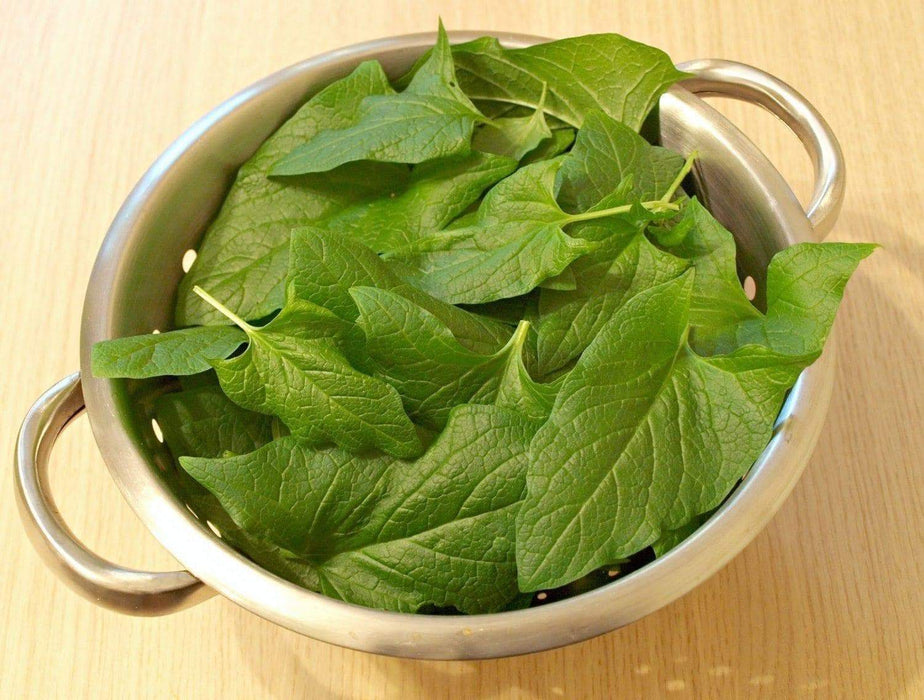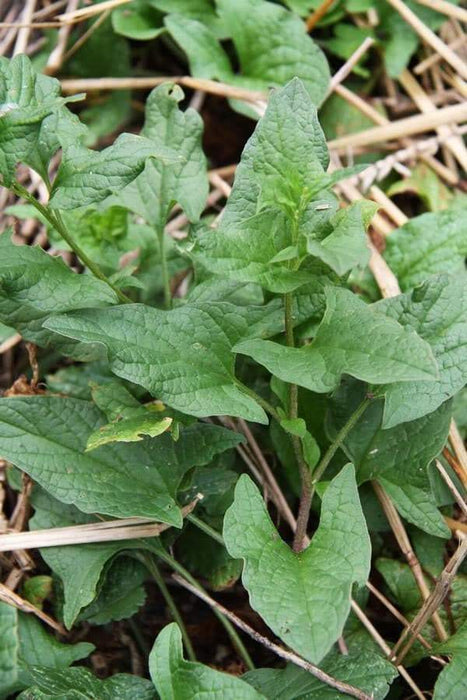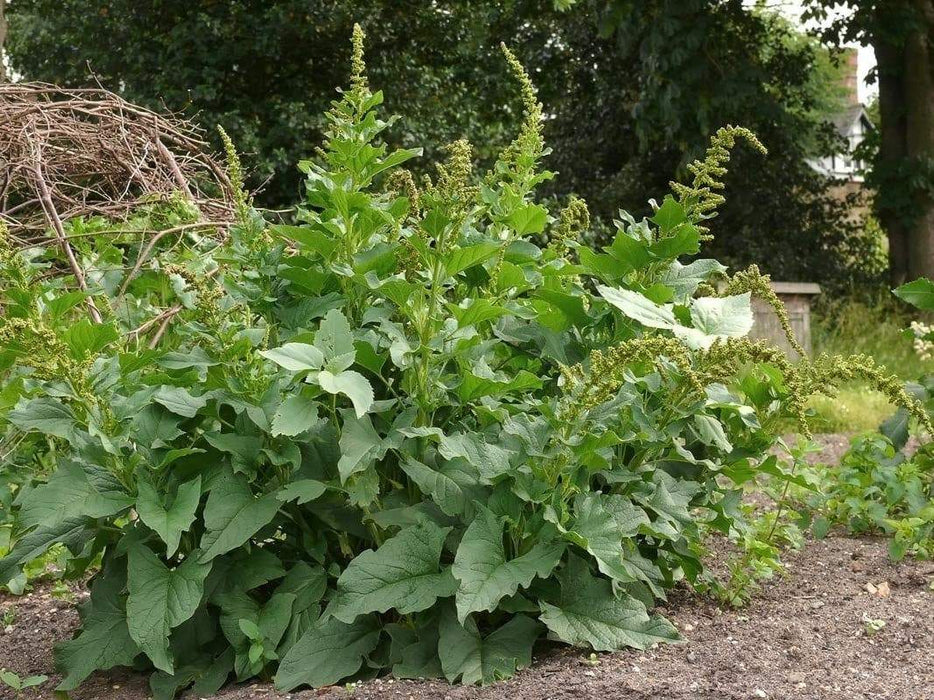
Good King Henry (OG) - Chenopodium bonus-henricus - Culinary/Medicinal, Perennial (hardy in zones 3-9)
Original price
$ 4.35
-
Original price
$ 5.45
Original price
$ 4.35
$ 4.35
-
$ 5.45
Current price
$ 4.35
Most orders are processed by the next day
Select your desired size and/or color from the available options.
Good King Henry
Chenopodium bonus-henricus
Uses: Culinary/Medicinal Duration: Perennial (hardy in zones 3-9)
When to Sow: Spring/Late Summer/Early Fall Ease of Germination: Easy
(Mercury; Wild spinach) Wholesome potherb rich in iron, calcium and vitamin C. In use since Neolithic times, it was brought to Europe some 5,000 years ago and has naturalized there. Good King Henry forms clumps of dark green leaves, growing 60cm/2ft in height. One of the earliest spring greens, Good King Henry is an interesting example of a once-common food that has since been forgotten and is seldom cultivated, although it is a perennial and can still be found growing around abandoned homesteads. It was a typical ingredient of medieval vegetable soups from the 12th to the 16th centuries, combining with leeks, chard and bread in a tasty, vitamin-rich broth that sustained the peasant farmers in their labours.
In the modern kitchen, shoots gathered when 12cm/5" high can be peeled, boiled and eaten like asparagus. Young tender leaves can be eaten cooked or added to salads like spinach, and the flower spikes can be steamed and buttered for a gourmet treat. Medicinally, it is a remedy for indigestion and constipation. It thrives in full or partial sun, but does well in part shade. Seeds may be slow to get going, but an established plant will self-seed if allowed to.
Cultivation---Good King Henry is well worth cultivating. Being a perennial, it will continue to produce for a number of years, being best grown on a deep loamy soil. The ground should be rich, well drained, and deeply dug. Plants should be put in about April, 1 foot apart each way, or seeds may be sown in drills at the same distance. During the first year, the plants should be allowed to establish themselves, but after that, both shoots and leaves may be cut or picked, always leaving enough to maintain the plant in health. Manure water is of great assistance in dry weathe.
As with many of the wild plants, it does not always adapt itself to a change of soil when transplanted from its usual habitat and success is more often ensured when grown from seed.
Dodoens says the name Good King Henry, was given it to distinguish the plant from another, and poisonous one, called Malus Henricus ('Bad Henry'). The name Henricus in this case was stated by Grimm to refer to elves and kobolds ('Heinz' and 'Heinrich'), indicating magical powers of a malicious nature. The name has no connexion with our King Hal.
The name 'Smear-wort' refers to its use in ointment. Poultices made of the leaves were used to cleanse and heal chronic sores, which, Gerard states, 'they do scour and mundify.'
The roots were given to sheep as a remedy for cough and the seeds have found employment in the manufacture of shagreen.
The plant is said to have been used in Germany for fattening poultry and was called there Fette Henne, of which one of its popular names, Fat Hen, is the translation.
Usual seed life: 5 years.
Planting Depth 1/4â
Soil Temp. Germ. 60ËF stratify
Days to Germ. 70-80
Plant Spacing 12-18â
Row Spacing 24â
Days To Maturity 300
Part Shade, Moist Well Drained
Materials: seed,organic,Vegetable seeds,Red Malabar spinach Seeds,Red Malabar,annual,perennial,Basella Rubra,Warm season annual,Caucasian Spinach Seeds,Caucasian,Mountain Spinach,Hablitzia tamnoides Select your desired size and color from the available option
Chenopodium bonus-henricus
Uses: Culinary/Medicinal Duration: Perennial (hardy in zones 3-9)
When to Sow: Spring/Late Summer/Early Fall Ease of Germination: Easy
(Mercury; Wild spinach) Wholesome potherb rich in iron, calcium and vitamin C. In use since Neolithic times, it was brought to Europe some 5,000 years ago and has naturalized there. Good King Henry forms clumps of dark green leaves, growing 60cm/2ft in height. One of the earliest spring greens, Good King Henry is an interesting example of a once-common food that has since been forgotten and is seldom cultivated, although it is a perennial and can still be found growing around abandoned homesteads. It was a typical ingredient of medieval vegetable soups from the 12th to the 16th centuries, combining with leeks, chard and bread in a tasty, vitamin-rich broth that sustained the peasant farmers in their labours.
In the modern kitchen, shoots gathered when 12cm/5" high can be peeled, boiled and eaten like asparagus. Young tender leaves can be eaten cooked or added to salads like spinach, and the flower spikes can be steamed and buttered for a gourmet treat. Medicinally, it is a remedy for indigestion and constipation. It thrives in full or partial sun, but does well in part shade. Seeds may be slow to get going, but an established plant will self-seed if allowed to.
Cultivation---Good King Henry is well worth cultivating. Being a perennial, it will continue to produce for a number of years, being best grown on a deep loamy soil. The ground should be rich, well drained, and deeply dug. Plants should be put in about April, 1 foot apart each way, or seeds may be sown in drills at the same distance. During the first year, the plants should be allowed to establish themselves, but after that, both shoots and leaves may be cut or picked, always leaving enough to maintain the plant in health. Manure water is of great assistance in dry weathe.
As with many of the wild plants, it does not always adapt itself to a change of soil when transplanted from its usual habitat and success is more often ensured when grown from seed.
Dodoens says the name Good King Henry, was given it to distinguish the plant from another, and poisonous one, called Malus Henricus ('Bad Henry'). The name Henricus in this case was stated by Grimm to refer to elves and kobolds ('Heinz' and 'Heinrich'), indicating magical powers of a malicious nature. The name has no connexion with our King Hal.
The name 'Smear-wort' refers to its use in ointment. Poultices made of the leaves were used to cleanse and heal chronic sores, which, Gerard states, 'they do scour and mundify.'
The roots were given to sheep as a remedy for cough and the seeds have found employment in the manufacture of shagreen.
The plant is said to have been used in Germany for fattening poultry and was called there Fette Henne, of which one of its popular names, Fat Hen, is the translation.
Usual seed life: 5 years.
Planting Depth 1/4â
Soil Temp. Germ. 60ËF stratify
Days to Germ. 70-80
Plant Spacing 12-18â
Row Spacing 24â
Days To Maturity 300
Part Shade, Moist Well Drained
Materials: seed,organic,Vegetable seeds,Red Malabar spinach Seeds,Red Malabar,annual,perennial,Basella Rubra,Warm season annual,Caucasian Spinach Seeds,Caucasian,Mountain Spinach,Hablitzia tamnoides Select your desired size and color from the available option
LET OUR CUSTOMER SPEAK FOR US

![[Seeds] - Caribbeangardenseed](http://caribbeangardenseed.com/cdn/shop/files/gift-card-gift-card-1_1024x1024_dfa857db-9150-4315-a362-7f0bb3fb9c47_60x28.png?v=1703978838)



